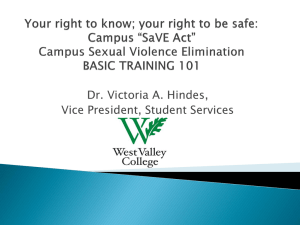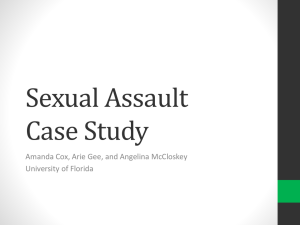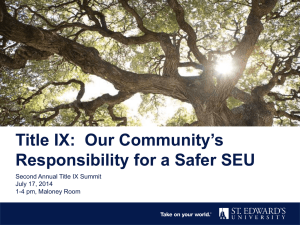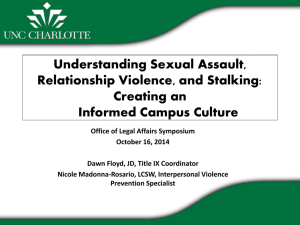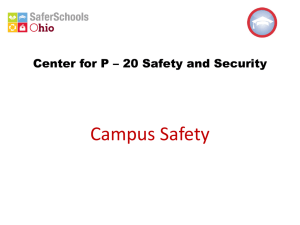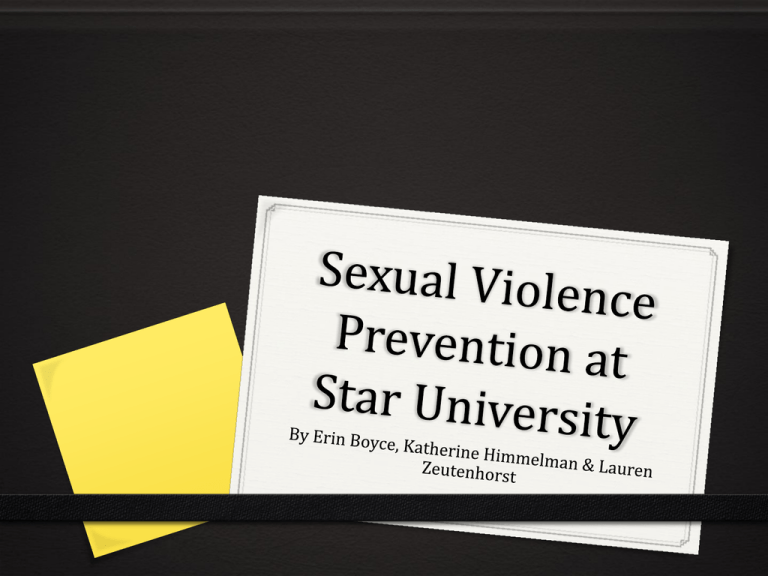
Introduction
0 We believe in the importance of reducing sexual
violence on our college campus through the expansion
and creation of comprehensive efforts that engage all
members of the University community. These efforts
will include the continual education of community
members.
0 The following presentation outlines the information
on which recommendations are based as well as the
actual recommendations for implementation on
campus.
Overview
0 National statistics on the prevalence of sexual assault
on college campuses
0 Federal Legislation
0 Important sexual assault literature and implications
0 Existing prevention models
0 Our recommendations for the campus
What is Sexual Assault?
0 (n.) illegal sexual contact that usually involves force
upon a person without consent or is inflicted upon a
person who is incapable of giving consent (because of
age, physical, or mental incapacity) or who places the
assailant (as a doctor) in a position of trust or
authority.
(“Sexual Assault." Merriam-Webster.com)
Why does this matter in
higher education?
0 “Victims of sexual assault are more likely to suffer
academically and from depression, post-traumatic
stress disorder, to abuse alcohol and drugs, and to
contemplate suicide.”
(U.S. Department of Education, Office of Civil Rights, 2011)
Additional terms for
consideration
0 Intimate partner violence
0 Stalking
0 Dating violence
0 Sexual violence
0 Domestic violence offenses
Statistics
0 In 2007, 3.9% of college women reported attempted
or actual sexual penetration against their will
0 10.6% reported sexual touching against their will
0 1.9% reported a sexually abusive relationship
0 College men also reported on the same statistics with
1.4% indicating attempted or actual sexual
penetration against their will
0 4.4% reported sexual touching against their will
0 1.3% reported a sexually abusive relationship
(American College Health Association, 2009)
According to an ACHA Preventing Sexual
Violence Survey...
0 When 297 respondents were asked “To what extent
do you think your institution is effective in addressing
the problem of sexual violence?” ONLY 11.8% said
very effective
0 When the same sample was asked “How familiar are
you with Bystander Intervention techniques to
address prevention of sexual violence?” 38.2% said
they were not familiar at all
(American College Health Association, 2009)
Current Regulations for
College Campuses
1. Department of Education Office of Civil Rights
2. Violence Against Women Act’s (VAWA)
Reauthorization
3. Campus Sexual Violence Elimination Act (SaVE)
4. Jeanne Clery Act
Department of Education
Office of Civil Rights
0 Title IX – 1972
0 Dear Colleague Letter – issued in 2011
Violence Against Women Act’s
(VAWA) Reauthorization
0 Signed by President Obama on March 7, 2013
0 Strengthened and reauthorized the Violence Against
Women Act (1994)
0 Included in the bill was the Campus Sexual Violence
Elimination Act (Campus SaVE)
0 Amended the Jeanne Clery Act
Campus Sexual Violence
Elimination Act (SaVE)
0 “The campus SaVE Act seeks to address the violence
women face on campus: the highest rates of stalking,
the highest risk of nonfatal intimate partner violence,
and 20-25% of female students experiencing rape or
attempted rape.”
Campus Sexual Violence
Elimination Act (SaVE)
Goal: to compliment Title IX and update Jeanne Clery
Act to generate….
0 Transparency
0 Accountability
0 Education
0 Collaboration
Jeanne Clery Act
0 This landmark federal law “requires colleges and
universities across the United States to disclose
information about crime on and around their campus.
The Law is tied to an institution’s participation in
federal student financial aid programs and it applies
to most institutions of higher education both public
and private”
Jeanne Clery Act
Requirements
0 Publish and Annual Security Report (ASR)
0 To have a public crime log
0 Disclose crime statistics for incidents that occur on campus, in
obstructed public areas adjacent to or running through the campus and
at certain non campus facilities
0 Issue timely warnings about Clery Act crimes which pose a serious or
ongoing threat to students and employees
0 Devise an emergency response, notification, and testing policy
0 Compile and report fire data to the federal government and publish an
annual fire safety report
0 Enact policies and procedures to handle reports of missing students
Jeanne Clery Act – 7 Major
Categories of Crime Reporting
1. Criminal Homicide
2. Sexual Offenses
3. Robbery
4. Aggravated Assault
5. Burglary
6. Motor Vehicle Theft
7. Arson
Literature on Sexual Violence in Higher
Education
0 American College Health Association:
0 Shifting the Paradigm: Primary Prevention of Sexual Violence
0 Guidelines: Position Statement on Preventing Sexual Violence
on College and University Campuses
0 U.S. Department of Education Higher Education Center
0 Getting Started on Campus: Tips for New Prevention
Coordinators
0 Preventing Violence and Promoting Safety in Higher Education
Settings: Overview of a Comprehensive Approach
Shifting the Paradigm
0 Ways of prevention:
1. Identify social norms that support sexual violence
2. Strengthen sense of community
3. Target entire community
4. Link to alcohol campaigns
5. Use peer educators
Disseminating Information
0 New Student Orientation
0 Residence Hall Programs
0 Sorority and Fraternity Housing
0 Organization, Clubs, and Teams on Campus
0 Academic Departments
0 Campus Radio Stations
0 Parents
0 Community Groups
Focus on Men
0 10 Ways Young Men Can Prevent Sexual Violence
0 By focusing on the 10 ways of prevention, ideas about
ending sexual violence can hopefully spread among
men.
0 Although not all men will commit acts of sexual
violence, they can still play a role in educating each
other through basic daily practices
Position Statement- ACHA
2011
0 Importance of engaging the community
0 14 Step Plan of Recommended Actions – focuses on all
levels of the University and the community
Getting Started – The Higher
Education Center
0 Critical Elements of Prevention:
0 Engaging partners across campus and in the community in
creating solutions
0 Fully understanding the problem
0 Being fully aware of best practices in sexual violence
prevention
0 Creating a strategic plan to address the issue
0 Connecting with all constituents of the University and the
community
Taking Control of the
Environment
0 To prevent sexual violence, it is crucial to cultivate a University
environment that does not run-counter to the no-tolerance
policy associated with such activities.
0 Options include:
0 Offer activities that do not involve alcohol (proven to
contribute to sexual violence culture)
0 Create an environment centered on the promotion of health
norms
0 Restrict marketing and promotion of events and products
on and off campus that may contribute to sexual violence
culture
0 Enforce the policies and efforts
Creating Effective Programs
0 Programs must be based on the needs articulated by
assessment data related to sexual violence on campus
0 Measurable goals and objectives as identified by
assessment
0 Prior effective prevention efforts
0 Use of evaluation tools
Current Examples of Practice
0 The Sexual Assault Violence Prevention Program at
Vassar College
0 SART programs
0 Pomona College Advocates for Survivors of Sexual
Assault
The Sexual Assault Violence
Prevention Program
0 The Sexual Assault Violence Prevention Program (SAVP) is
housed within the Office of Health Education.
0 SAVP provides campus programming and education about sexual
assault, relationship abuse, and stalking by working closely with
community partners to increase campus awareness and to
generate dialogue
0 This information is also housed within the Freshman handbook
0 Sexual Assault Response Team is included in this effort
Sexual Assault Response
Team (SART)
0 Focus on the victim and their individual situation
0 Core members
0 “…provide interagency, coordinated responses that
make victims’ needs a priority, hold offenders
accountable, and promote public safety.”
SART Strengths
0 Minimize both short and long-term impacts of victim
trauma
0 Help to affirm victims concerns and address different
options for dealing with said concerns
0 Improves communication between different
constituencies involved.
Pomona College Advocates
0 Student advocates
0 On and off campus support listings
0 Promotion of self care
0 Basic information for supporting victims
One-in-Four
0 Men’s Program
1. Help men understand how to help women recover from rape.
2. To increase the likelihood of bystander intervention in potentially
high-risk situations
3. To challenge men to change their own behaviors and influence the
behavior of others.
0 Women’s Program
1. Enable women to recognize characteristics of high-risk perpetrators.
2. Enable and Empower women to intervene in potentially high risk
situations
3. Enable women to help rape survivors
Our Recommendations
0 Addition of Title IX Coordinator position
0 Program Creation and Evaluation:
0 SART
0 Bystander Education across campus constituencies
0 Advocacy program
0 Safe-space technology map
0 One-in-Four groups
0 Report training
0 Poster and Social media campaign
Recommendations
0 We believe it is important for high level administrators and our
task force to create an action statement that recognizes the
existence of sexual violence to be adopted by campus
constituencies as a show of solidarity in Star University sexual
violence protection efforts.
Recommendations
0 Our conduct system should be evaluated to insure
that it follows a “no-tolerance” policy for sexual
violence that places victims as the priority. Although
following the judicial process is crucial, victims should
be protected and feel safe by the granting of
protection orders on campus and the creation of safe
spaces on campus for victims at all times.
References
0
0
0
0
0
0
0
0
0
0
0
American College Health Association, (2009). Shifting the paradigm: Primary prevention of sexual violence.
Retrieved from website: http://www.acha.org/sexualviolence/
Langford, L. U.S. Department of Education, The Higher Education Center for Alcohol and Other Drug Abuse
and Violence Prevention. (n.d.). Preventing violence and promoting safety in higher education settings:
Overview of a comprehensive approach. Retrieved from website:
http://hazingprevention.org/images/stories/preventing-violence-promoting-safety-highered.pdf
One in four programs. (n.d.). Retrieved from http://www.oneinfourusa.org/index.php
Pomona college advocates. (n.d.). Retrieved from http://poadvocates.com/about-us
SART toolkit: Resources for sexual assault response teams. (n.d.). Retrieved from http://ovc.ncjrs.gov/sartkit/
“Sexual Assault." Merriam-Webster.com. Merriam-Webster, n.d. Web. 21 Feb. 2014. http://www.merriamwebster.com/dictionary/sexual assault
Sexual assault and violence prevention. (n.d.). Retrieved from http://savp.vassar.edu/
Stubbs, H. U.S. Department of Education, The Higher Education Center for Alcohol and Other Drug Abuse and
Violence Prevention. (2008). Getting started on campus: Tips for new prevention coordinators. Retrieved from
website: http://safesupportivelearning.ed.gov/sites/default/files/hec/product/getting-started.pdf
Summary of the jeanne clery act. (n.d.). Retrieved from http://clerycenter.org/summary-jeanne-clery-act
The campus sexual violence elimination (save) act. (n.d.). Retrieved from clerycenter.org/campus-sexualviolence-elimination-save-act
U.S. Department of Education, Office of Civil Rights. (2011). Dear colleague letter: Sexual violence background,
summary, and fast facts. Retrieved from website:
http://www.whitehouse.gov/sites/default/files/fact_sheet_sexual_violence.pdf

